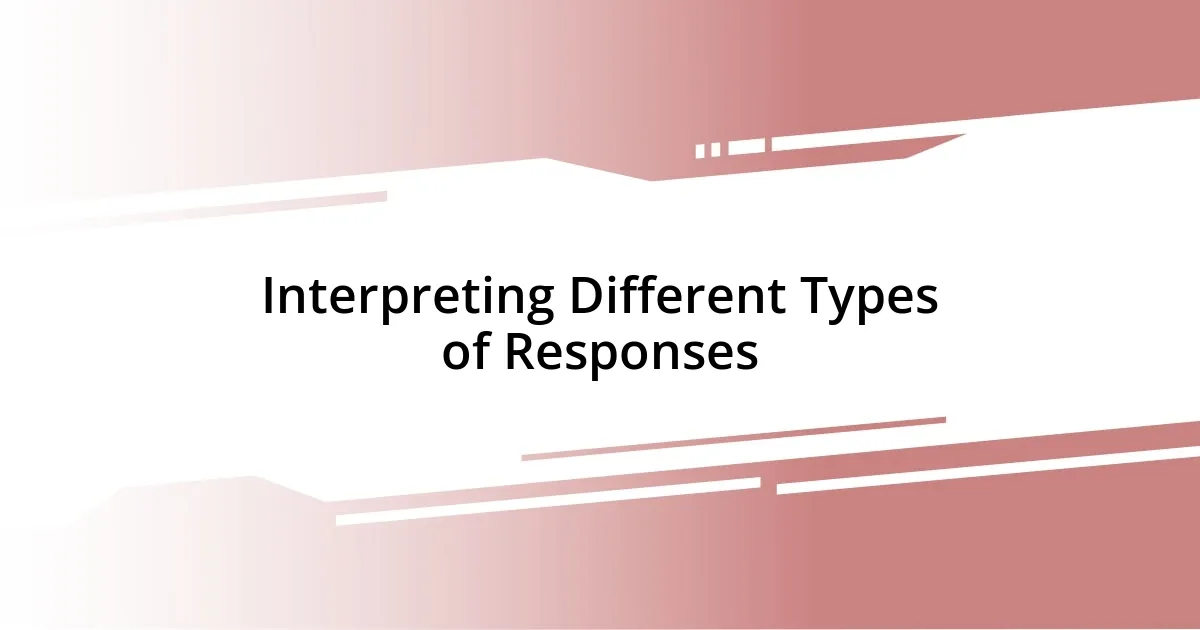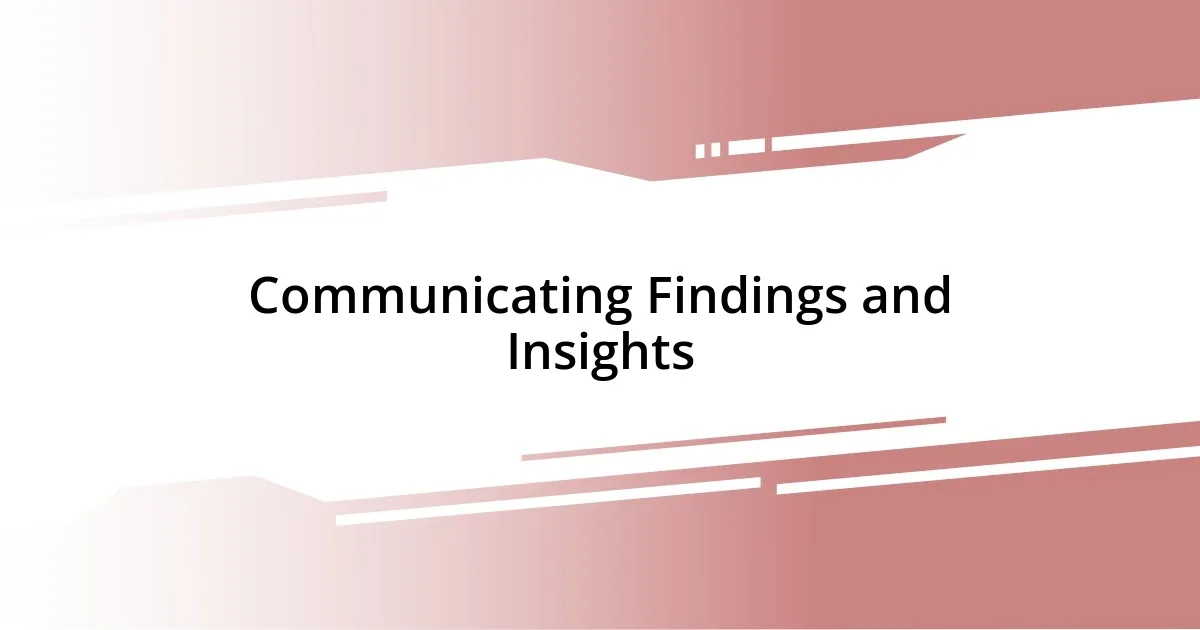Key takeaways:
- Understanding survey results involves recognizing user experiences and emotions behind the data, not just analyzing numbers.
- Visualizing data through charts and graphs reveals patterns and trends that improve interpretation and inform strategies.
- Engaging with colleagues for collaborative interpretation enhances understanding and leads to actionable improvements based on feedback.
- Context is crucial in interpreting responses, as external factors can influence user feedback significantly.

Understanding Survey Results
Understanding survey results isn’t just about crunching numbers; it’s about uncovering the stories behind them. I remember when I first analyzed my survey data, feeling a mix of excitement and trepidation. What was the real message hidden within those responses?
When I dive into the data, I often find myself looking for patterns and trends. For instance, in one survey, the majority expressed confusion about a particular feature I thought was clear. This made me realize how vital it is to put myself in the respondents’ shoes – what seems straightforward to me can be perplexing to others.
I’ve learned that emotions play a crucial role in interpreting survey results. When participants took the time to share their frustrations or joys, it struck a chord with me. Isn’t it fascinating how a single response can open up a discussion about user experiences and expectations?

Analyzing Survey Data Effectively
When analyzing survey data, I find it essential to approach the results with an open mind. I’ve often discovered insights that weren’t immediately obvious. For example, during a recent analysis, I stumbled upon a surprising correlation between user age and preferences for certain features. This little nugget changed how I targeted my marketing strategy and solidified my belief that demographics matter more than I initially thought.
To ensure I’m effectively interpreting the data, I rely on several key strategies:
– Visualize the Data: Charts and graphs help me see patterns I might miss in raw numbers.
– Segment the Responses: Breaking down the data by demographics or other factors can reveal hidden insights.
– Look for Outliers: Odd responses can provide important clues or highlight areas that need attention.
– Compare with Past Data: Understanding trends over time helps gauge if changes are significant.
– Solicit Feedback: I often discuss findings with colleagues to refine my interpretations and catch blind spots.
Each of these strategies enables me to connect more deeply with the narratives behind the numbers.

Identifying Key Trends and Patterns
Identifying key trends and patterns from survey results is an art and a science for me. During one of my surveys, I was taken aback when a significant number of respondents mentioned they found my app difficult to navigate. This stark feedback prompted me to reevaluate the design. It was a humbling moment that reminded me of the importance of user-centric design, where the end-user’s experience is paramount.
There’s something really fascinating about spotting trends. I recall another instance where I noticed a spike in feedback regarding a new feature I implemented. Initially, I struggled with mixed reviews, but upon deeper analysis, I recognized a clear trend: younger users were far more enthusiastic about it than older ones. This insight reshaped how I approached user tutorials and support resources, maximizing engagement by catering to the specific demographic’s needs. Recognizing these patterns genuinely feels like piecing together a puzzle.
As I sift through data, creating a comparison table can be particularly illuminating. The act of organizing the responses allows me to see connections that might have eluded my initial analysis. Here’s a simple representation of how I approach this:
| Demographic | Feature Preference |
|---|---|
| 18-24 | Interactive Tutorials |
| 25-34 | Detailed Help Guides |
| 35+ | In-Person Support |
This table reflects how different groups engage with various forms of assistance, guiding my efforts to tailor content and outreach effectively. It’s enlightening how a simple layout can crystalize complex insights!

Interpreting Different Types of Responses
Interpreting different types of responses can be quite a journey for me, filled with surprises. I remember analyzing a survey where responses varied from straightforward approval to vehement criticism. It was intriguing how a handful of respondents expressed their disdain for a particular feature, while others praised it to the skies. This stark contrast reminded me that feedback isn’t just binary; it showcases the diverse experiences of users. Isn’t it fascinating that one person’s treasure can be another’s trash?
In my experience, open-ended responses often provide the richest insights. During one analysis, I asked users what they wanted to see improved in my app. One comment stood out: a user felt the app didn’t align with their values concerning sustainability. That feedback wasn’t just about functionality; it struck a chord with my commitment to environmental responsibility. Such nuances often lead me to rethink not only features but also the broader mission of my work. Have you ever had feedback that completely shifted your perspective?
Finally, I’ve noticed the importance of context when interpreting responses. While reviewing a recent survey’s quantitative data, I came across a series of negative ratings. At first, I felt a twinge of anxiety. However, diving deeper, I realized that these responses coincided with a major app update that had unintentionally introduced bugs. Recognizing this context reshaped my interpretation and allowed me to address the root causes appropriately. Doesn’t it feel incredible how context can completely change the narrative?

Visualizing Data for Clarity
Visualizing data effectively has been a game changer for me in understanding survey results. A while ago, I created a series of pie charts to illustrate user satisfaction ratings. Seeing the percentages laid out visually hit me differently than just reading numerical data. It was startling to realize that nearly 45% of respondents rated their experience as “poor”—a stark visual that pushed me to prioritize changes immediately. Have you ever found that numbers suddenly come to life when depicted visually?
Another technique I’ve enjoyed is using bar graphs to compare different demographics. I remember plotting responses on features across various age groups, and what stood out was the clear divide. The younger audience overwhelmingly favored gamified elements, while older users preferred straightforward functionalities. This comparison didn’t just inform me; it sparked creativity to bridge the gap, leading to experiments that blended engaging with simplicity. When I see those bars, I not only gather insights, but I also feel inspired to innovate. How does data visualization evoke a sense of creativity in your work?
Combining visualizations with storytelling is my secret sauce. Once, after presenting my findings on user engagement through visuals, I shared a narrative about a user who transitioned from hesitant to enthusiastic. This user’s journey was highlighted through a line graph showing their improving satisfaction over time. Watching my audience connect emotionally with the data was remarkable. It made me appreciate how leading with visuals can transform dry statistics into relatable stories that foster a deeper understanding. Have you ever had that moment where data and real-life experiences collide, creating a powerful narrative?

Drawing Actionable Conclusions
Drawing actionable conclusions from survey results requires me to delve deep into the data, moving beyond surface-level interpretations. For instance, I recall a time when I stumbled upon a surprising insight: despite a decent average satisfaction score, a significant number of respondents were expressing doubts about recommended updates. This discrepancy prompted me to reach out to some of those dissatisfied users, which ultimately led to a transformative dialogue. Isn’t it enlightening when you realize that digging a little deeper can reveal hidden trends?
What’s even more crucial is translating these insights into specific actions. After analyzing feedback about my product’s user interface, I decided to prioritize a series of small but impactful tweaks. One change involved simplifying navigation based on user comments about confusion during use. This wasn’t just about aesthetics; it was about creating a more intuitive experience for my users. Have you ever felt the thrill of transforming feedback into tangible improvements?
Moreover, I find that involving my team in the conclusion-drawing process amplifies the impact of the survey results. During one brainstorming session, we reviewed the data together and created an action plan that addressed the core issues identified by respondents. It was rejuvenating to witness everyone’s unique perspectives shaping our next steps. This collaborative spirit not only enhances accountability but also fosters a sense of ownership within the team. How about you? Have you ever seen your team come alive by directly addressing feedback?

Communicating Findings and Insights
Communicating findings effectively is essential for ensuring that insights resonate. I recall a particular presentation where I shared my survey results with visuals but realized that my words weren’t connecting. To bridge that gap, I decided to create a narrative around the data—a compelling story of a user’s journey. This approach not only clarified my findings but also stirred genuine interest among my audience. Have you ever noticed how a story can transform dry data into engaging conversations?
Another instance that stands out is when I summarized complex results during a team meeting. Instead of bombarding my colleagues with spreadsheets, I crafted a concise report paired with key visuals. I emphasized the most surprising insights and encouraged questions throughout. Watching my teammates nod and engage made me appreciate how simplicity can amplify understanding. Have you found that presenting findings in an easily digestible format cultivates more meaningful discussions?
I also cherish the moments when feedback flows both ways. After sharing insights, I invited my colleagues to discuss their interpretations and insights. This open dialogue sparked new ideas on evolving our strategy based on the results. It was fascinating to see how different perspectives enriched the conversation, allowing us to refine our action plan together. Have you experienced the power of collaborative interpretation, where collective wisdom enhances the final outcomes?














